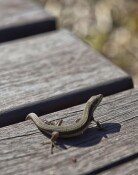Okcheon County offers feed to wild boars in pilot test to cut damage
Okcheon County offers feed to wild boars in pilot test to cut damage
Posted July. 01, 2017 07:21,
Updated July. 01, 2017 07:54

The county used all different methods while capturing 274 wild boars last year, but damage has not lessened. Then, the county got a suggestion that it provides feed to starving wild boars. It seeks to proactively provide feeds to hungry wild boars. If wild boars are full after eating the feed, they will not come to farm fields or houses to cause damage. The logic was that simple.
Has the county’s drastic experiment worked? Initially, the strategy helped block wild boars from coming to villages. There were footprints of wild boards that were seen having returned to the forest after eating sweet potatoes and carrots. The frequency of wild boars’ appearing around fruit farms has also declined.
“The accurate analysis of the strategy can only be done in the harvest season when farmers suffer heaviest damage,” said Kwak Gyeong-hoon, head of the environmental planning team at the county office. “If the analysis suggests some effect, we will expand the program to other areas.”
Experts have doubts about the viability of the program despite its possible short-term effect. Wild boars could cause more severe damage to crops as they come to learn through experience.
If wild animals such as elk and wild boars are provided with feed, even animals that perish through natural selection can survive. On the other hand, since carnivores that feed on those animals are smaller in number, the strategy could result in a collapse of balance in the ecosystem, many say.
Experts say that customized strategies are needed for different groups of wild animals including those that are defined as harmful species such as wild boar and endangered species such as mountain goat.
Youn-Jong Kim zozo@donga.com






